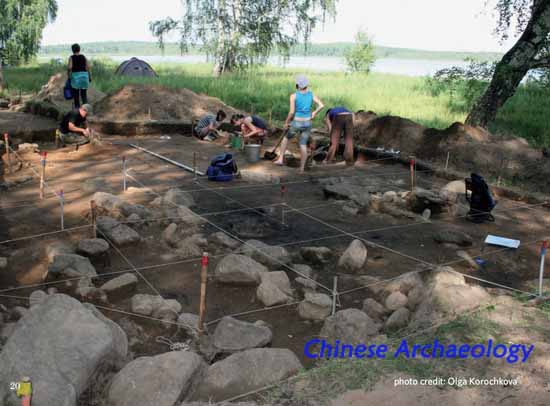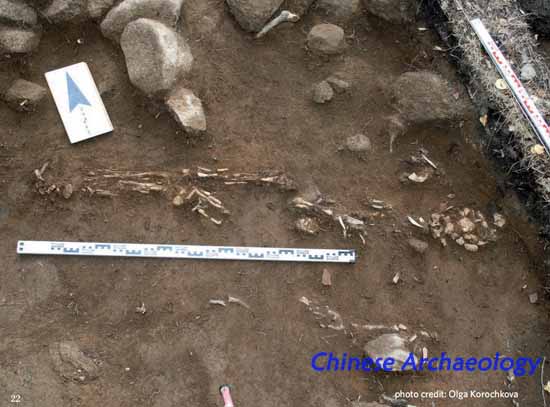Sacral Place of the First Metallurgists of Urals
The sacral site Shaitanskoye Ozero II (which is referred to as Shaytanka) largely changed the views on the problem of transition from the Stone Age to the Bronze Age and the formation of metallurgical centers in Northern Eurasia.
The turn of the third and second millennia B.C. in Central Asia is marked by so-called Seima-Turbino (ST) phenomenon. It is characterized by sudden appearance of a highly developed metallurgy with tin alloys and special technologies by the method of «blind sleeve». Widespread Seima-Turbino bronzes come from either ritual sites or accidental finds within the huge territory of the Northern forest-steppe and the taiga stretching from Northern China to the Baltic Sea, outside of a reliable cultural context. This makes it difficult to understand this Eurasian phenomenon. Almost complete absence of bronzes of ST-type in the Middle Urals looked very strange against the background of richest concentration of local copper deposits.

In 2006-2007, on the coast of the lake Shaitanskoye (near Yekaterinburg), professor. Y. Serikov accidently discovered a unique complex containing a huge number of metal products, comparable with ST- bronzes which were accompanied by local Bronze Age pottery. Further excavations of the site (2008-2013) under his direction demonstrated a unique sacral character of the site, comparable to the famous ST ritual sites of Rostovka, Seima, and Turbino.
This ritual place produced rather strong magnetic anomaly, reaching +3° /+49°. On its surface there are no visible structures. On a partial area of 950 sq.m about 220 bronze items, stone arrowheads, and ceramics have been excavated. Most of them formed compact accumulations. The objects were placed on the edge, or stuck vertically, in pairs, or inserted one into another, some of them preserved the remains of a fabric or birch bark. More than 230 arrowheads of specific form, made of chalcedony and flint are found on the surface. Some of them were broken. Raw materials and technology are not typical for the local stone industry. Several graves containing cremation remains, including charred skeletons of 35-50 years old males, were excavated on the site periphery. One of them was accompanied by a dagger with a decorated handle. A separate cult complex is located near the graves. It is a shallow pit in the bottom of which two bracelets are found, and on its outskirts were four vessels, inserted into one another.

Despite the affinity to the other famous ST antiquities, the Ural’s site has a pronounced originality. The metal assemblage includes as typical ST samples and original Uralian products and previously unknown types. Most of the objects are made of alloys with tin content from 3 to 8 %. Content and composition of impurities (zinc, lead, arsenic) is unstable. Singular objects are cast from pure copper. There is every reason to believe that in the nineteenth-eighteenth centuries BC, the Seima-Turbino metallurgists contributed the formation of the independent Uralian metallurgical and metalworking center, which absorbed also the achievements of producing centers of the steppe zone.
The Uralian center was formed due to close cooperation of the Seiam-Turbino groups with aboriginal population, which is, apparently, knew the local outputs of oxidized copper ores (malachite, cuprite, azurite and others). Another important factor is the communications with the population of the adjacent steppe territory. It is not excluded, that it was in the form of prestigious exchange of gifts and marital ties. Where were the ores mined and metal produced? There are reasons to think that this occurred in the nearest environment. In particular, the traces of metal production (crucibles, casting molds) are available in the local settlement located in 10-50 km from the Shaitanka site. The posed question will be answered in the near future.

For who was the weapons mastered? This is perhaps the most difficult question. The matter is that in the Urals, the metal product of this type is accumulated mainly in the ritual and burial complexes, the settlements are very rare. It is believed that the majority of the perfect weapon was intended as a gift to the gods-demiurges. Such a ritual corresponds to the universal practice of alienation of metal in the sacred sphere in the first moment of its appearance in the human culture.
The discovery and investigation of the site of Shaytanka highlighted the fate of the Seima-Turbino metallurgy in Northern Eurasia, and showed the model of the introduction of the metallurgy into the hunter, fisher and gatherer society. This site can be also regarded as the new link in of the network of distribution of advanced metallurgy in Eurasian space.
Olga Korochkova (The Ural Federal University)
Biographical sketch
Olga Nikolaevna Korochkova is assistant professor at the Department of Archaeology and Ethnology in the Ural Federal University, Russia. Dr. Korochkova was born in the family of a metallurgical engineer in 1959. From 1975 through 1980, Korochkvoa studied at the Ural State University, and she pursued a graduate program at the Institute of Archaeology in Moscow. Korochkova obtained her doctoral degree in archaeology from the Institute of Archaeology at the Russian Academy of Sciences with the thesis titled “Interaction of Cultures in the Bronze Age in the Trans Urals and in the Forest-Steppe of Tobol-Irtish: Side Factors, Mechanisms, Dynamics” (2011). Dr. Korochkova’s research interest focuses on the archaeological study of Northern Eurasia during the Bronze Age. Also she had a special interest in the study of Andronovo culture. In the past five years Dr. Korochkova has been devoted to the study of the cult place of ancient metallurgists in the Ural.

